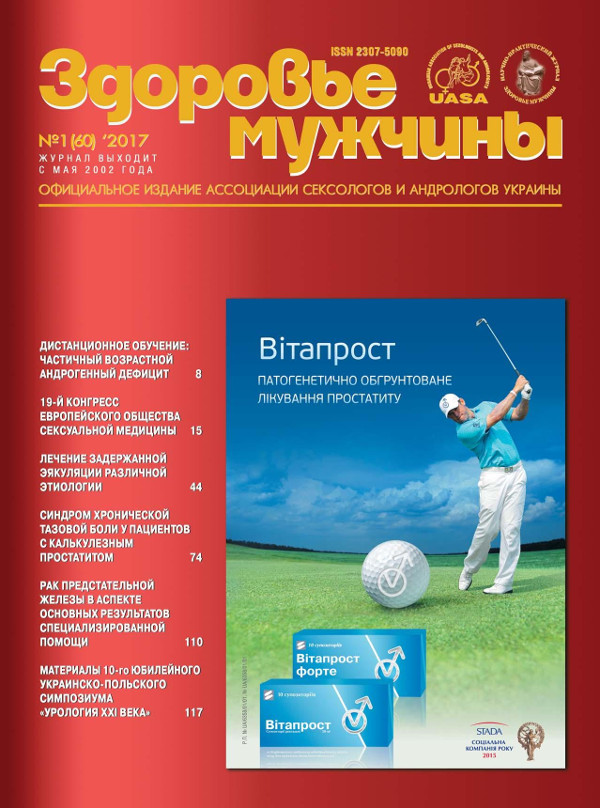Complex evaluation of prognostic factors for biochemical recurrence after radical prostatectomy for patients with clinical locally advanced prostate cancer
##plugins.themes.bootstrap3.article.main##
Abstract
Materials and methods. During the period from August 2002 to June 2015, 419 patients with PCa were hospitalized on the basis of the Institute of Urology of the Academy of Medical Sciences of Ukraine RPE, of which 106 patients (25.3%) had clinical stage sT3N0M0. The average follow-up period was 55.7 months.
Results. Based on the main clinical risk factors, a model of prognostic stratification of locally advanced PCa was developed into three subgroups: low risk – in the absence of data on invasion of seminal vesicles (stage cT3a), prostate-specific antigen (PSA) <20 ng / ml, Gleason score with biopsy Ј6; Intermediate risk – in the presence of one of the unfavorable factors of the forecast: stage cT3v, PSA ≥20 ng/ml, Gleason ≥7; нigh risk – in the presence of two or more negative prognostic factors. Biochemical relapse in the groups of low, intermediate and high risk was revealed in 14.3%, 37.1% and 70.2% of patients (p<0.05), respectively, and the risk of its development in patients with intermediate risk increased 3.0 times , нigh – 8.5 times.
Conclusion. This stratification can be useful for practical specialists and researchers in choosing the optimal treatment tactics for patients with stage III prostate cancer.
##plugins.themes.bootstrap3.article.details##

This work is licensed under a Creative Commons Attribution 4.0 International License.
Authors retain the copyright and grant the journal the first publication of original scientific articles under the Creative Commons Attribution 4.0 International License, which allows others to distribute work with acknowledgment of authorship and first publication in this journal.
References
Arnold M., et al. Recent trends in incidence of five common cancers in 26 European countries since 1988: Analysis of the European Cancer Observatory. Eur J Cancer, 2015. 51: 1164.
Gnanapragasam VJ, Mason MD, Shaw GL, Neal DE. The role of surgery in high-risk localised prostate cancer. BJU Int. 2012;109(5):648–658.
Gerber GS, Thisted RA, Chodak GW et al. Results of radical prostatectomy in men with locally advanced prostate cancer: multi-institutional pooled analysis. Eur Urol 1997; 32: 385–90.
Ward JF, Slezak JM, Blute ML, Bergstralh EJ, Zincke H. Radical prostatectomy for clinically advanced (cT3) prostate cancer since the advent of prostate-specific antigen testing: 15-year outcome. BJU Int 2005; 95: 751–6.
Loeb S, Smith ND, Roehl KA, Catalona WJ. Intermediate-term potency, continence, and survival outcomes of radical prostatectomy for clinically high-risk or locally advanced prostate cancer. Urology 2007; 69: 1170–5.
Sanda MG, Dunn RL, Michalski J et al. Quality of life and satisfaction with outcome among prostate-cancer survivors. N Engl J Med 2008; 358: 1250–61.
Xylinas E, Dachй A, Rouprкt M. Is radical prostatectomy a viable therapeutic option in clinically locally advanced (cT3) prostate cancer? // British Journal of Urology International. 2010;106(11):1596–1600.
Yossepowitch O. Secondary therapy, metastatic progression, and cancer-specific mortality in men with clinically high-risk prostate cancer treated with radical prostatectomy/O. Yossepowitch, S.E. Eggener, A.M. Serio et al. // Eur. Urol. – 2008. – Vol. 53 – P. 950–959.
Carver B.S. Long-term outcome following radical prostatectomy in men with clinical stage T3 prostate cancer/B.S. Carver, F.J. Bianco Jr., P.T. Scardino, J.A. Eastham// J. Urol. – 2006 – Vol. 176 – P. 564–568.
Sobin L.H. International Union against Cancer.7th ed. 2009 / Sobin L.H., Gospodarowicz M.K., Wittekind Ch. // Chichester, West Sussex, UK; Hoboken, NJ : Wiley-Blackwell – 2010 – P. 243–8.
Yossepowitch O., Eggener S.E., Bianco F.J. Jr. et al. Radical prostatectomy for clinically localized, high risk prostate cancer: critical analysis of risk assessment methods//J Urol. 2007; 178: 493–499.





